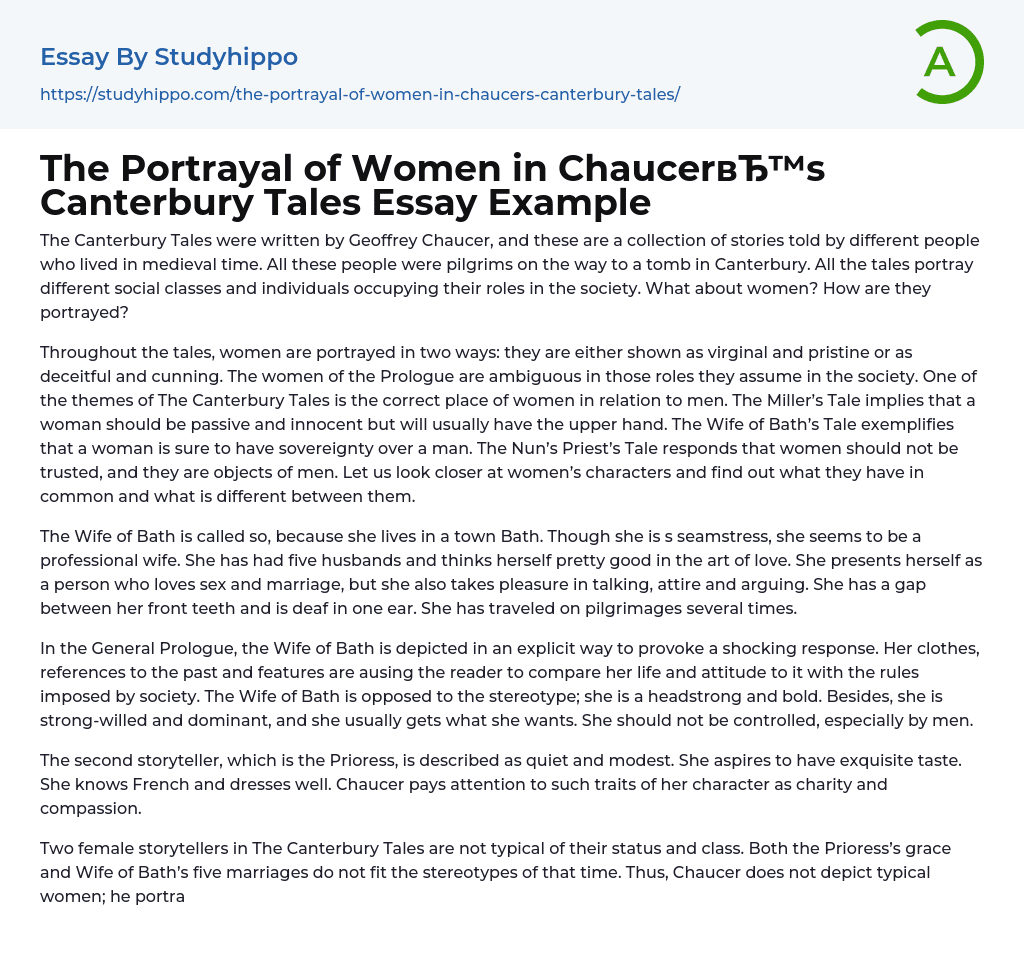

The Portrayal of Women in Chaucer’s Canterbury Tales Essay Example
The Canterbury Tales were written by Geoffrey Chaucer, and these are a collection of stories told by different people who lived in medieval time. All these people were pilgrims on the way to a tomb in Canterbury. All the tales portray different social classes and individuals occupying their roles in the society. What about women? How are they portrayed?
Throughout the tales, women are portrayed in two ways: they are either shown as virginal and pristine or as deceitful and cunning. The women of the Prologue are ambiguous in those roles they assume in the society. One of the themes of The Canterbury Tales is the correct place of women in relation to men. The Miller’s Tale implies that a woman should be passive and innocent but will usually have the upper hand.
...The Wife of Bath’s Tale exemplifies that a woman is sure to have sovereignty over a man. The Nun’s Priest’s Tale responds that women should not be trusted, and they are objects of men. Let us look closer at women’s characters and find out what they have in common and what is different between them.
The Wife of Bath is called so, because she lives in a town Bath. Though she is s seamstress, she seems to be a professional wife. She has had five husbands and thinks herself pretty good in the art of love. She presents herself as a person who loves sex and marriage, but she also takes pleasure in talking, attire and arguing. She has a gap between her front teeth and is deaf in one ear. She has traveled on pilgrimages several times.
In the General Prologue
the Wife of Bath is depicted in an explicit way to provoke a shocking response. Her clothes, references to the past and features are ausing the reader to compare her life and attitude to it with the rules imposed by society. The Wife of Bath is opposed to the stereotype; she is a headstrong and bold. Besides, she is strong-willed and dominant, and she usually gets what she wants. She should not be controlled, especially by men.
The second storyteller, which is the Prioress, is described as quiet and modest. She aspires to have exquisite taste. She knows French and dresses well. Chaucer pays attention to such traits of her character as charity and compassion.
Two female storytellers in The Canterbury Tales are not typical of their status and class. Both the Prioress’s grace and Wife of Bath’s five marriages do not fit the stereotypes of that time. Thus, Chaucer does not depict typical women; he portrays the opposite poles of woman’s nature. The feelings of the Prioress are contrasted to senses of the Wife of Bath, the sensibility of the first is opposed to elemental vitality of the second.
The Prioress submitted to the Church and tried to fit her temperament into it. She violates the laws of her order subtly by overdressing, keeping pets and taking on to a pilgrimage. The opposition to woman’s passiveness is the Wife of Bath’s aggressive demonstration of her appetites and instincts. The Wife of Bath does not try to fit her temperament into something. She conversely makes church, marriage and pilgrimage serve her character. The two basic traits of her are the experience and the desire for mastery.
One more contrast between the Wife of Bath and the Prioress is brought up by religious issues: the first embodies knowledge of facts, the second – blind religious faith. The Wife of Bath is the lusty and extravaagant, while the Prioress is the devoted follower of church.
By contrasting different abstract issues, the author created vivid women’s characters. Playing with their characters, habits and facts, Chaucer makes them self-sufficient.
But for these two women, there is one more woman character. This is Alisoun, the sexy young woman married to the carpenter. She appears in The Miller’s Tale. Alisoun is bright; she dresses in a tantalizing way. The Miller through his tale shows that he sees women as passive and innocent. Speaking about Alisoun, he compares her with many objects conveying a sense of innocence. She is a passive participant in story’s love triangle. By the end of the story, she has the upper hand over her husband and her lover, has an advantage over all the men. Through this ending, Miller illustrates that the passivity allows many advantages in a relationship.
One may compare the characters of Alisoun and the Wife of Bath. Unlike Alisoun, the Wife of Bath never cheated on her husband and, unlike Alisoun, she married older men not because of love but because of their money. At the age of forty, the Wife of Bath found the love of her life, and Alisoun never got much from Nicolas, because she is still a wife of the carpenter.
As to the Chaucer’s attitude towards the women, he portrayed in The Canterbury Tales, it cannot be defined as anti-feministic. His women characters are attractive
and splendid, and his attitude towards them is shown as a complex one, and it definitely differs from those of his contemporaries. It is based on the contrasts and uncommonness, and these characteristics pay our attention to Chaucer’s women characters and make us compare them.



